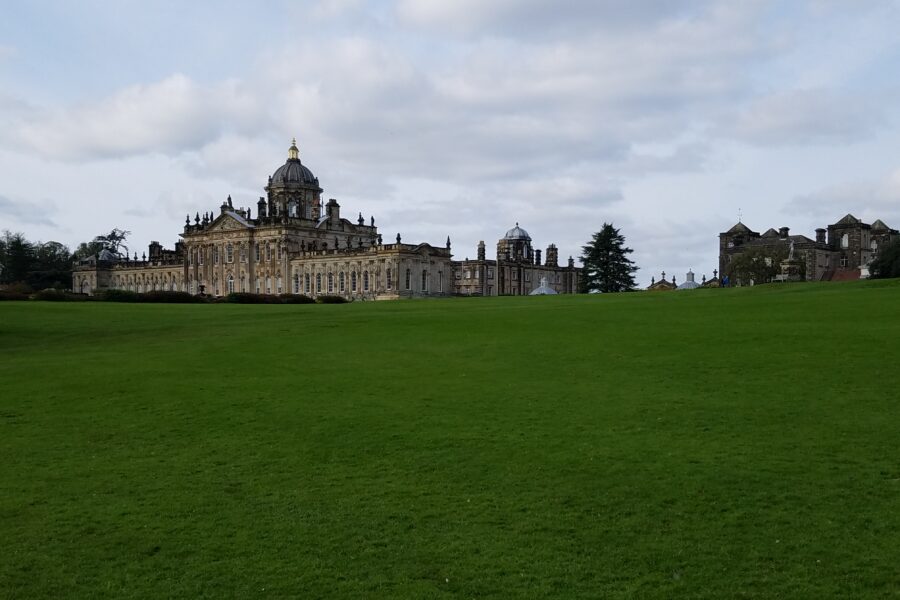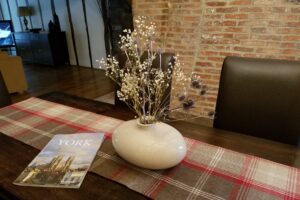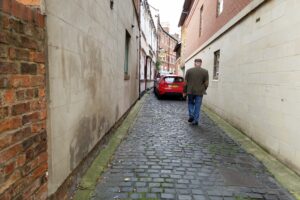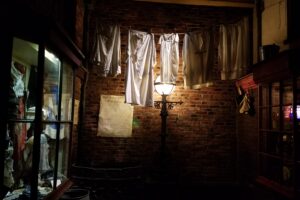Michael doesn’t even ask what Castle Howard is. He grabs the car keys. I grab my walking shoes. We take the long trek to the car and head east toward the Moors, turning north before we get there. We approach the road that leads to the entrance only to see a sign telling us that the road is closed.
Diverted traffic must turn left away from the castle. We follow arrow shaped Diversion signs down gray ribboned roads heading back to York, then north toward Scotland, twisting and turning, going nowhere till the final Diversion sign leads us through the back door of the centuries old estate.
I think I know what is in store for us—in bite size increments only—it has been fed to me piecemeal on Instagram since March when I started following every British Travel site I could find. I remember a façade that goes on longer than forever with a majestic dome at the center. However, even though we are finally here, I can’t see a thing.
We hike from the end of the parking lot toward the visitors entrance, purchase tickets, walk through the cobblestoned courtyard of the stables, along an extensive garden wall, and finally I see it. An edifice any state capitol would be proud to call its own. The splendor of the façade calls to Michael. He walks forward and down to get a better view, ignoring all of the signs to the entrance.


At the top of the stairs where the self-guided tour begins we are greeted by a smiling docent who asks us if we have been to Castle Howard before. When she hears our answer and our accent, she takes us aside and gives us the most wonderful chatty informative history lesson. We not only learn about the house but the multi generations of family who lived here for 300 hundred years, and still do, and the man who built this palatial estate—the important Earl, the one we really care about.


Charles Howard, 3rd Earl of Carlisle, PC (c. 1669 – 1 May 1738) Elected as MP for Morpeth in 1689. He was appointed Governor of Carlisle from 1693 to 1728 and Lord-Lieutenant of Cumberland and of Westmorlandfrom 1694-1714. William III made him a Gentleman of the Bedchamber between 1700 and 1702, First Lord of the Treasury from 1701 to 1702 and Privy Counsellorin 1701. He acted as Earl Marshal between 1701 and 1706 because his cousin, the Duke of Norfolk, was a minor. On Queen Anne’s death on 1 August 1714 he was appointed Lord Justice of the Realm until the arrival of King George I on 18 September 1714. The new king reappointed him as First Lord of the Treasury from 23 May 1715 to 10 October 1715 and made him Constable of the Tower of London between 1715 and 1722.
“I could talk to you all day,” she says. And I could listen. I want to take her home with me, put her in my pocket and cart her around; sit forever having tea and listening. She is my ideal guide since I am always more interested in the individual behind the structure than I am in the architecture of it—I tell her so, and then I ask her a question.
“But what I’m totally curious about is…”
“So, where did he get his money. Is that what you are wondering?”
Yes, yes and yes.
The third Earl of Carlisle, a British nobleman, peer, and statesman, inherited it (ah, the accidents of birth) and married it—his wife came to the marriage with 80,000 acres from her father in the Lake’s District—and managed it well. And he was a very important man. We progress through the centuries of portraits surrounding us, hearing a tidbit here and a sermon there concerning the individual—wives, children, passions.
Still not hearing enough about the individuals who inhabited this place, my attention is finally drawn to the massive china cabinet that covers one wall. I learn more—I love this woman! Walking close to the cabinet she points out the set of Meissen China—also centuries old—that is hand painted with such exquisite detail that my fingers itch to hold just one piece and look at it under a magnifying glass.


Taking up too much of her time, reluctantly I turn and begin exploring this opulent castle which boasts 145 rooms, many gutted during WWII when a fire broke out in 1940. It was during the period a girl’s school, Queen Margaret’s School in Scarborough, had been evacuated to Castle Howard. The dome, the central hall, the dining room and the state rooms on the east side were entirely destroyed as well as the dome collapsing. The fire took the Malton and York Fire Brigades eight hours to bring under control.


As we wander from room to room, words fail. A bedroom, the antique passage—containing statues from as early as the 1st century—and great hall take my breath away, knock my socks off, overwhelm—take your pick. Each room has placards with information and a docent available to answer any questions. I think this may be my favorite tour ever—seeing and learning at my own pace.




I love the statues—I am surprised there are any left in Rome. The library. The books—I am delighted when I see several of them with the word Tome on their spine. The stories. I make a note to find copies of Brideshead Revisited—both the 1981 British TV mini-series and the 2008 movie, so I can revisit this amazing space once I am home.

We enter a room filled with photos and words and timelines, all the information I crave. I could spend a day in here just reading. I wish I had the ability to retain everything I see. It is the 20th century history that I can relate too, and of course the thoughts and actions and deaths of the family during WWII hold my attention.



I think I knew, but somehow forgot that the British elite were rather enamored with Hitler in the beginning, as is evidenced by this letter from the future heir of Castle Howard.

Exhausted by sensory overload we have lunch—hot soup for Michael, a creamy individual Quiche Lorraine for me—before beginning our tour of the grounds—1,000 acres. I don’t think we can see all of it without total collapse.


We stop often, finding benches scattered around the grounds, enjoying the sun. The view. The magnificence of the English countryside. I think Capability Brown would have approved. Finally reaching the Temple of the Four Winds I am consumed by curiosity as to the state of decay of the exterior. It is as black as the soot encrusted temples of Rome. I can’t understand it—there are no cars. Michael points out the obvious—black mold. “Nothing ever gets a chance to dry out.” Of course.




Reluctantly we end the long day, Michael warning me he is not going back on the Diversion road—too narrow. Too curving. Too hilly. “I’ll let Jeeves figure it out—how to get us home.” He noses the Toyota toward Scotland.
I think Jeeves is in trouble…from the speaker of the GPS I hear, “Turn around when possible…”
Michael ignores the instructions.

















Leave a Reply
Your email is safe with us.